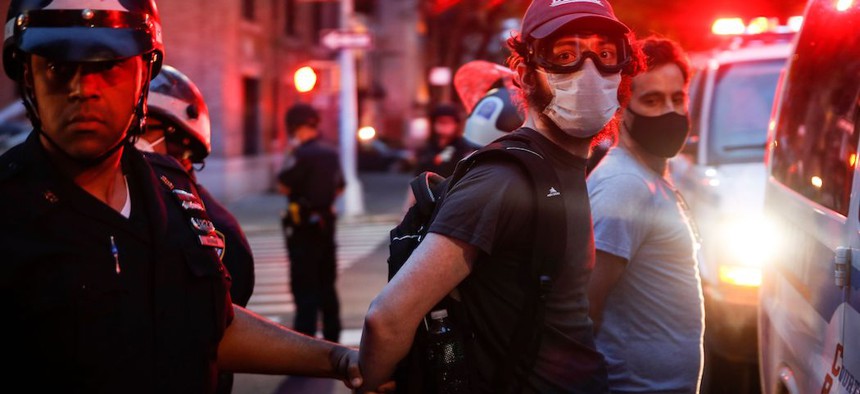The NYPD hasn’t earned much love these past few weeks. But even so, police unions’ recent claims that a Shake Shack employee deliberately spiked officers’ milkshakes with bleach seemed like a stretch – and was quickly disproved by the NYPD’s own investigators. The real explanation may just be that the fast food workers hadn’t properly cleaned the machine used to make the shakes.
This isn’t the first time accusations against criminal suspects or anti-police brutality protesters have been published without sufficient fact-checking or scrutiny, leading to media outlets sharing false information. Some of the worst examples have happened on a national level, with Fox News sharing digitally altered and misleading images to criticize protests. Locally, Fox’s sister newspaper, the New York Post, routinely shares police narratives. Often these are with anonymous sourcing, zero additional verification and in contradiction of facts that are later reported by the Post itself – sometimes later in the very same story. Here are some the Post’s recent pro-police propaganda – some call it “copaganda” – articles.
The Rolex looting that never happened
“Looters swipe $2.4M worth of watches from SoHo Rolex store: police sources,” blared the Post’s article on June 1. But that claim was contradicted by the article, which cites the store’s spokesman as saying no watches had been stolen, as none were even on display. There isn’t even a “Rolex store” at that location but another watch store that is authorized to sell Rolexes. The Post’s story has since been updated – though no note has been added to reflect the changes – but describes the discrepancy between anonymous police sources and the store itself as “conflicting reports.”
Concrete “ice cream”
Police officers sounded the alarm: protesters may be stocking up on containers of concrete disguised as chocolate chip ice cream. But photos of those containers publicized by the Post are actually just coffee cups used by construction workers to test the composition of the concrete mix. The Post didn’t acknowledge that fact until halfway through the article, as well as the fact that there were no reports that they’ve been used as weapons by protesters.
“Strategically” placed bricks
Claims of concrete disguised as ice cream aren’t the only construction-related accusations police have lobbed at protesters. NYPD Commissioner Dermot Shea tweeted a video featuring boxes piled on a street corner, captioned, “This is what our cops are up against: Organized looters, strategically placing caches of bricks & rocks at locations throughout NYC.” But City Councilman Mark Treyger, who represents the area, said there hadn't been any looting in the area and the likelier explanation is that it is debris left over from a nearby construction site. Though the Post’s recounting of the story includes the councilman’s assertion in the lede, both the headline and the first half of the article largely propagate Shea’s claims.
Essential or not essential
Essential workers were meant to be exempt from curfews imposed earlier this month to curtail protests against systemic racism and police brutality. But in practice, that hasn’t been the case. The NYPD shot back in the case of one viral video of a delivery worker getting arrested arguing he wasn’t on the job when police detained him. But the app company he worked for confirmed he’d actually been actively making deliveries that evening. Not that he didn’t make that clear when he yelled at the arresting officers: “It tells me on the app that I can show you guys something. It tells me that I can show you guys, you can’t arrest me.” Though the Post published a follow-up article with the correct account, the original falsely asserting police claims remains online.
Omissions in the Barbot mask fiasco
The Post sparked a major controversy with an article asserting that New York City’s health commissioner told a high-ranking NYPD officer, “I don’t give two rats’ asses about your cops,” when the police asked for masks at the height of the COVID-19 pandemic. But reporting from other outlets highlight some major omissions in the story. The conflict was triggered when a group of cops showed up without warning at an out-of-state warehouse filled with coveted N-95 masks set aside for healthcare workers and the exchange was reportedly “heated” on both sides, according to the Daily News. This was in the middle of March, when coronavirus cases were spiking and doctors and nurses were increasingly in need of protective equipment. Though Commissioner Oxiris Barbot’s comments certainly were undiplomatic, the additional details not included in the Post’s accounting don’t paint the police as totally innocent in the exchange.
Boogeyman bail reform
The Post led the charge in running articles critical of New York’s bail reform law, implemented at the start of this year. The now-amended law no longer allowed judges to set bail for many misdemeanor charges and nonviolent crimes. Headline after headline in the Post showed how people managing to avoid jail because of the new bail law would go on to reoffend. The publication also shared an argument from the NYPD that the law caused an uptick in crimes without acknowledging concerns that there hadn’t been sufficient time to evaluate the law’s impact. But one egregious case – also propagated by the Daily News – shows how that narrative can be inappropriately distorted by police sources. Both papers wrote that a man set free under the bail law went on to attempt to sexually assault a woman despite the fact that he hadn’t even been charged with a crime related to the attempted sexual assault. As of February, that case was still being investigated. He was released from jail last December after being held on robbery charges, and when he was re-arrested this year, it was in connection to theft.
NEXT STORY: Dual elections take place for the fate of NY-27


